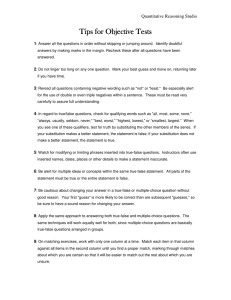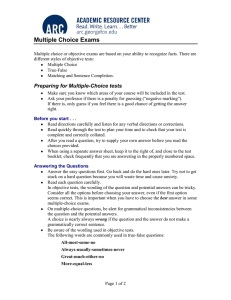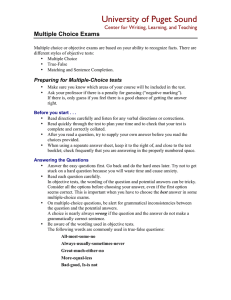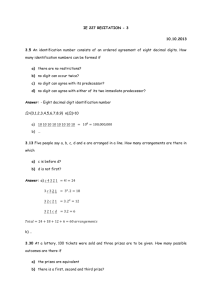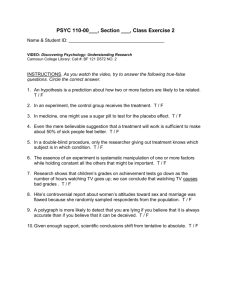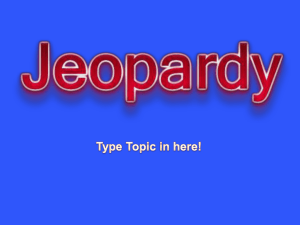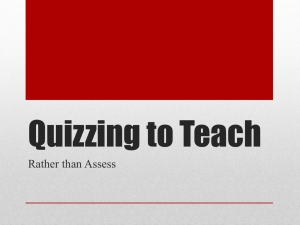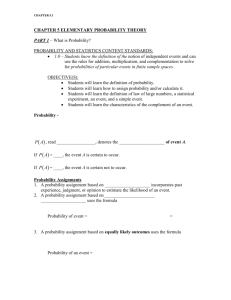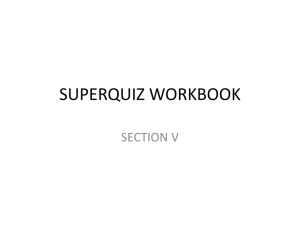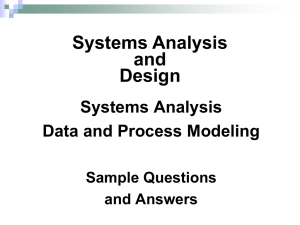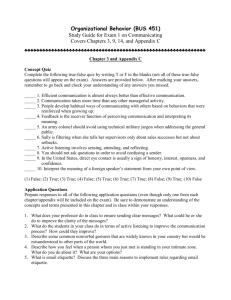True or false
advertisement
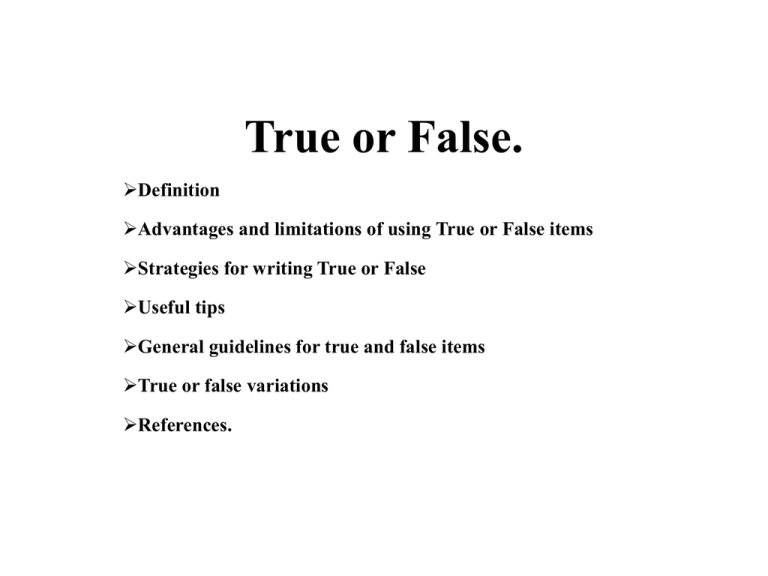
True or False. Definition Advantages and limitations of using True or False items Strategies for writing True or False Useful tips General guidelines for true and false items True or false variations References. True or false….. Definition: In the most basic format, true-false questions are those in which a statement is presented and the student indicates in some manner whether the statement is true or false. In other words, there are only two possible responses for each item, and the student chooses between them. • True or false questions are often deceiving as you may think they are easy to answer. You only have the choice of either true or false as your answer. However, these questions can be more difficult than they look. • True-false questions require the students to select a response (true or false) that shows recognition of correct or incorrect information that is presented to them. These are included among the items that are called "selection," in contrast to "supply" items in which the student must supply the correct information. Another term applied to these items is "forced choice". • True-false questions are well suited for testing student recall or comprehension. Students can generally respond to many questions, covering a lot of content, in a fairly short span of time. From the teacher's perspective, these questions can be written quickly and are easy to score. Because they can be objectively scored, the scores are more reliable than for items that are at least partially dependent on the teacher's judgment Advantages in using true-false items • True-false items can provide: • the widest sampling of content or objects per unit of testing time • scoring efficiency and accuracy • versatility in measuring all levels of cognitive ability • highly reliable test scores • an objective measurement of student achievement or ability Limitations of using true-false items • incorporate an extremely high guessing factor • can often lead an instructor to write ambiguous statements due to the difficulty of writing statements which are unequivocally( plain ideas) true or false • do not discriminate between students of varying ability as well as other item types • can often lead an instructor to favor testing of trivial knowledge (less important/ inessential) • The compound questions can allow for more sophisticated questioning of understanding, but the fill-in-the blank portion of the question takes more time and leads to scoring ambiguities. Strategies for True-False Tests 1. Avoid Over generalizing Poor: heavy smoking causes lung cancer. T/F Better: heavy smoking often causes lung cancer. T/F 2.Avoid Trick questions Eg: gigantism and dwarfism in human basically depend on the quality and quantity of food eaten during early growing age. 3. Statements should be entirely true or entirely false. As you know a true or false test is made up of several statements, assessing your knowledge of the objectives. Many statements will appear true because most of the statement is true. However, one word in the statement that makes it false, makes the entire statement false. Unacceptable: The kidney is red bean shaped structure. Internally, it is distinguished into two zones; an outer dark red zone cortex and inner pale red zone medulla. From the functional point of view, the kidney may be regarded as a collection of numerous neurons that are specialized for the conduction of impulse. Acceptable: • The kidney is a bean shaped structure. Internally, it is distinguished into two zones; the outer dark red zone cortex and inner pale red zone medulla. (T) • From the functional point of view, the kidney may be regarded as a collection of numerous neurons which are specialized for the conduction of impulse. (F) 4. Avoid using universal descriptors such as “never”, “non”, “always” and “all” Eg: aliphatic aldehydes and ketones having the same molecular formula will never show functional isomerism. 5. Avoid negative words as they are often overlooked by the students. Poor: Neon is not an inert gas. Better: sulphur is an inert gas 6.Donot include two ideas in one statement unless you are evaluating student’s understanding of cause and effect. • Poor: bats are found at night because they are nocturnal • Better: bats are nocturnal 7. Provide “T” and “F” beside each statement and ask students to circle the correct answer. 8. Include more false than the true statements in any given test and vary the number of false statements from test to test. Tendency to mark more true than the false. Discrimination between those who know the content and those who don’t is greater for false expressions. 9. Avoid using negative statements. Eg: Electrolytic conduction will “not” increase with the decrease in temperature. • Few guidelines suggested by some authors for writing true-false items include the following: • Statements should be relatively short and simple. • True statements should be about the same length as false statements. • The answers should not be obvious to students who don't know the material. • Sweeping broad general statements or absolutes (all, always, never, none, only), tend to be false, since the student need think of only a single incident in which it is untrue to mark it false. • A similar situation occurs with the use of "can" in a true-false statement. If the student knows of a single case in which something could be done, it would be true. • Ambiguous or vague statements and terms, such as "large," "long time," "regularly," "some," and "usually" are best avoided in the interest of clarity. Some terms have more than one meaning and may be interpreted differently by individuals. • Eg: A nickel is larger than a dime. (True if we are talking about diameter, false if we are talking about the monetary value.) • While one author recommends having about the same number of true and false statements, another suggests having a larger number of false statements. A good guideline is to vary the ratio of true/false statements from test to test or quiz to quiz so that students do not depend on previous tests for cues as to the balance of true and false questions. • If students are to write in a "T" or "F" to indicate answers, their handwriting can cause errors in marking. This can be avoided by having them circle or underline their answers ("T" or "F," "true" or "false"), which would be typed beside each question. • Determine that the questions are appropriately answered by "True" or "False" rather than by some other type of response, such as "Yes" or "No." • Finally, arrange the statements so that there is no discernible pattern of answers (such as T, F, T, F, T, F and T, T, F, F, T, T, F, F) for True and False statements. True or False Variations…. • Yes-No In this variation, the student responds "Yes" or "No" to each item as a variation of the True-False format. Eg: The nucleus of the cell is compared to the brain of human being. (Yes/no) Yet another variation of True-False question is the True-False Correction question. • Statements are presented, and each statement contains a key word or brief phrase that is underlined. It is not enough that a student correctly identify a statement as being false. To receive credit for a statement labeled false, the student must also supply the correct word or phrase which, when used to replace the underlined part of the statement, makes the statement a true one. • Eg: The entry of pollen tube through micropyle into the embryo sac is called chalazogamy • This type of item is more thorough in determining whether students actually know the information that is presented in the false statements. While a student might correctly guess that a statement is false, no credit would be given unless the student could change the statement to a true one by writing word/words to replace underlined word. • The teacher decides what word/phrase can be changed in the sentence; if students were instructed only to make the statement a true statement, they would have the liberty of completely rewrite the statement so that the teacher might not be able to determine whether or not the student understood what was wrong with the original statement. • If, however, the underlined word/phrase is one that can be changed to its opposite, it loses the advantage over the simpler true-false question because all the student has to know is that the statement is false and change "is" to "is not." Reference. Hopkins.K.D.(1998).Educational and Psychological: Measurement and Evaluation(8th ed). America, Allyn &Bacon. Raika.N.B.(2002).Distance Teacher Education Programme: Measurement & Education .Samtse, DTEP. Trige.A.D.(2000).A hand book of classroom Assessment. United States, Addison Wesley Longman,inc. Retrieved on 29th of March,2011 from http://www.brighthub.com/education/homework-tips/articles/46875.aspx#ixzz1I47vOeaY Retrieved on 30th March of 2011 from http://www.brighthub.com/education/homework-tips/articles/46875.aspx#ixzz1I47RVTrv Retrieved on 1st of April, 2011 from http://web.utk.edu/~mccay/apdm/t_false/t-f_b.htm
